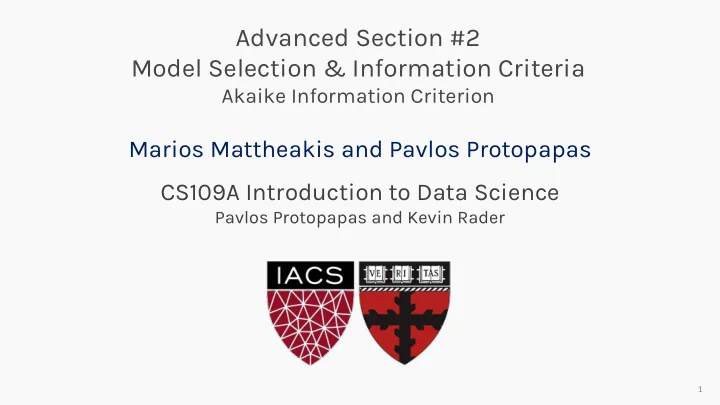

Advanced Section #2 Model Selection & Information Criteria Akaike Information Criterion Marios Mattheakis and Pavlos Protopapas CS109A Introduction to Data Science Pavlos Protopapas and Kevin Rader 1
Outline • Maximum Likelihood Estimation (MLE). Fit a distribution Exponential distribution • • Normal (Linear Regression Model) Model Selection & Information Criteria • • KL divergence • MLE justification through KL divergence Model Comparison • • Akaike Information Criterion (AIC) CS109A, P ROTOPAPAS , R ADER 2
Maximum Likelihood Estimation (MLE) & Parametric Models 3
Maximum Likelihood Estimation (MLE) Fit your data with a parametric distribution q ( y | θ ). θ =( θ 1 , … , θ k ) is a parameter set to be estimated. y CS109A, P ROTOPAPAS , R ADER 4
Maximum Likelihood Estimation (MLE) Fit your data with a parametric distribution q ( y | θ ). θ =( θ 1 , … , θ k ) is a parameter set to be estimated. y CS109A, P ROTOPAPAS , R ADER 5
Maximize the Likelihood L Scanning over all the parameters until find the maximum L ...but this is a too time-consuming approach. CS109A, P ROTOPAPAS , R ADER 6
Maximum Likelihood Estimation (MLE) A formal and efficient method is given by MLE Observations: y =(y 1 , …, y n ) Easier and numerically more stable to work with log-likelihood CS109A, P ROTOPAPAS , R ADER 7
Maximum Likelihood Estimation (MLE) Easier and numerically more stable to work with log-likelihood ⟹ CS109A, P ROTOPAPAS , R ADER 8
Exponential distribution: A simple and useful example A one parameter distribution: rate parameter λ CS109A, P ROTOPAPAS , R ADER 9
Linear Regression Model with gaussian error CS109A, P ROTOPAPAS , R ADER 10
Linear Regression Model through MLE Loss Function CS109A, P ROTOPAPAS , R ADER 11
Linear Regression Model: Standard Formulas Minimize the loss essentially maximize the likelihood, and we get CS109A, P ROTOPAPAS , R ADER 12
Model Selection & Information Theory: Akaike Information Criterion 13
Kullback-Leibler (KL) divergence (or relative entropy) How good do we fit the data? What additional uncertainty have we introduced? CS109A, P ROTOPAPAS , R ADER 14
KL divergence The KL divergence shows the distance between two distributions, hence it is a non-negative quantity. With Jensen’s inequality for convex functions 𝑔 𝒛 , 𝔽[𝑔 𝒛 ] ≥ 𝑔(𝔽 [ y ]): KL divergence is a non-symmetric quantity CS109A, P ROTOPAPAS , R ADER 15
MLE justification through KL divergence Empirical distribution Minimize KL divergence is the same with maximize likelihood (empirical distribution) log-likelihood CS109A, P ROTOPAPAS , R ADER 16
Model Comparison Consider to model distributions By using the empirical distribution: p is eliminated. CS109A, P ROTOPAPAS , R ADER 17
Akaike Information Criterion (AIC) AIC is a trade off between the number of parameters k and the error that is introduced (overfitting). AIC is an asymptotic approximation of the KL-divergence The data are being used twice: first for MLE and second for the KL-divergence estimation. AIC estimates which is the optimal number of parameters k CS109A, P ROTOPAPAS , R ADER 18
Polynomial Regression Model Example Suppose a polynomial regression model Which is the optimal k? For k smaller than the optimal: Underfitting For k larger than the optimal: Overfitting CS109A, P ROTOPAPAS , R ADER 19
Minimizing real and empirical KL-divergence Suppose many models indicated by index j Work with the j -th model which has k j parameters CS109A, P ROTOPAPAS , R ADER 20
Numerical verification of AIC CS109A, P ROTOPAPAS , R ADER 21
Akaike Information Criterion (AIC): Proof Asymptotic Expansion around true ideal MLE θ 0 CS109A, P ROTOPAPAS , R ADER 22
Akaike Information Criterion (AIC): Proof CS109A, P ROTOPAPAS , R ADER 23
Akaike Information Criterion (AIC): Proof In the limit of a correct model: CS109A, P ROTOPAPAS , R ADER 24
Review Maximum Likelihood Estimation (MLE) • A powerful method to estimate the ideal fitting parameters of a 1. model. Exponential distribution, a simple but useful example. 2. 3. Linear Regression Model as a special paradigm of MLE implementation. • Model Selection & Information Criteria 1. KL-divergence quantifies the “distance” between the fitting model and the “real” distribution. KL-divergence justifies the MLE and is used for model comparison. 2. AIC: Estimates the number of model parameters and protects from 3. overfitting. CS109A, P ROTOPAPAS , R ADER 25
Advanced Section 2: Model Selection & Information Criteria Thank you Office hours are: Monday 6-7:30 (Marios) Tuesday 6:30-8 (Trevor) CS109A, P ROTOPAPAS , R ADER 26
Recommend
More recommend